In the mix of communication tactics, business owners have multiple options from traditional advertising to social media and everything in between, but for quick results and a big bang, nothing beats using PR for promoting cannabis brand. Media relations is part of the PR package and it is great for reaching new audiences beyond your social media circle.
It might feel like traditional media is out of reach, but if you have a good story and are willing to pitch and follow up, the benefits are immense.
Here’s the story about how PR helped the start-up of Park Place Provisionary by Agri-Med and garner significant news coverage.
Park Place Provisionary is a locally-owned medical marijuana provisioning center in Muskegon, Michigan. It is also the first state-licensed center in the county and one of just a few on the in West Michigan. Those two things are notable and newsworthy and here’s why.
Increasingly, medical marijuana businesses in Michigan are owned by people who live outside the community. That’s because Michigan municipalities, for the most part, have opted-out of the zoning that allows them. So, with fewer places to locate, marijuana entrepreneurs are spreading out across the state and coming into communities where they have no connection.
We’ve seen it in Grand Rapids, Michigan’s second largest city where it is estimated that of the 80+ applicants for medical marijuana permits less than five are city residents. We’re not going to debate local ownership in this post. That being said, we think local ownership is the best option for a community.
The strategy we used to write the press release and make the pitch focused on local ownership and being the first to open in the market. We were able to use that hook to attract the attention of not only the Muskegon media but television stations in Grand Rapids, too.

Here’s some of the text from the press release and I’ve highlighted parts that made this newsworthy.
Highlights of the Press Release
The provisioning center located at 1922 Park Street in Muskegon is owned by Muskegon resident and long-time business owner Greg Maki. Maki bought and renovated an old trucking and freight terminal for the provisioning center.
The building has undergone extensive renovation, connecting with city water and sewer, landscaping, lighting, and comprehensive security and surveillance, making the building secure, compliant and accessible. Located in Muskegon’s marijuana overlay district, Maki’s business is the first to be completed and opened in Muskegon.
“It’s great to be able to open my business in the place where I live. Being part of the community helped with everything from securing the property to working on-site every day to finding local contractors,” said Maki. Part of his motivation for getting into medical marijuana was to create a business where his sons and other close family members would want to work. His nephew Aaron Smith is the financial manager and his partner Tracy Powers is vice president. Other company leaders include non-family members. Charles Bronkema is the operations manager, and Cindy Devenport is Park Place’s compliance manager. In all 13 new jobs were created at the facility.
Agri-Med was the 9th applicant for a medical marijuana license when the state began licensing in December 2017; it was the 5th prequalified license that the state issued.
Hooks and Visuals for Cannabis PR
Park Place Provisionary was lucky to have so many good hooks: local, family and first. The media used those and also focused on the building renovation and how marijuana was improving a languishing industrial park in Muskegon.
We also created a small event, a ribbon cutting and grand opening for the store. It’s traditional for new businesses to cut a ribbon, and doing this at Park Place Provisionary helps normalize cannabis to people in the community. A ribbon cutting also allows the business owner to invite family, friends, elected officials and community leaders to gather and be part of the celebration.

In public relations terms—the event and announcement was a home run. We garnered coverage from three television stations, several local newspapers and a public radio station, a business paper and an online hyperlocal news site. It’s a great example of how using PR for promoting a cannabis brand can bring new customers.
The initial impact was good for Park Place—they went from seeing about 20 customers in the first few days of the soft opening to a peak of more than 100 after the ribbon-cutting. Keeping the momentum is the next step—communicating with patients via text and email, using social media and cannabis digital outlets to grow the business. And always looking for the next story to share with the media.
Results
Here are some of the links to the media stories that Canna Communication secured for Park Place Provisionary showing how using PR for promoting a cannabis brand can work and the messages that come across.
From Mlive, Muskegon’s newspaper and online news source. Another story was on West Michigan’s ABC affiliate, WZZM 13. The store also was featured on the local Fox affiliate, Fox17. Park Place Provisionary was also on the air at West Michigan’s public radio station WGVU.
Muskegon Times Muskegon’s online hyperlocal news site wrote this story.
WOODTV8 West Michigan’s NBC affiliate did an advance before the grand opening.
Let’s Talk About Your Cannabis PR
If you are opening a new facility or have another story to share related to your cannabis business or want to explore how using PR for promotion your cannabis brand can help you grow give us a call.
Public relations is our specialty. Contact Roberta F. King, APR to get the conversation started.


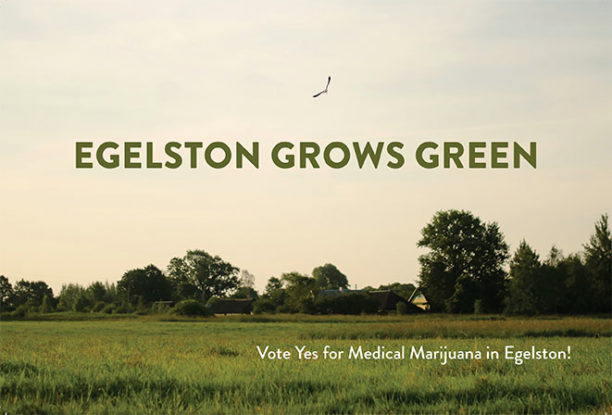
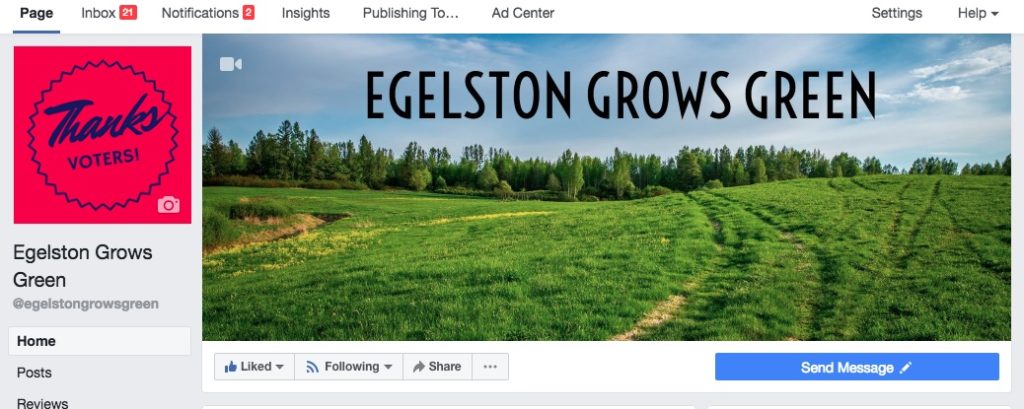
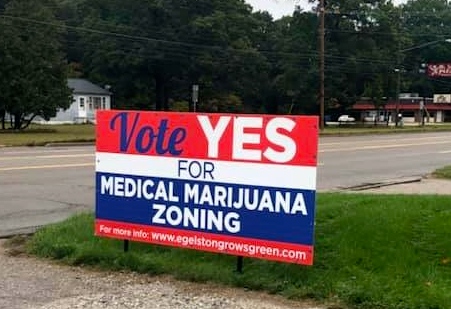 One month before the election we helped the client with a succinct, clear message for yard signs and designed a postcard for voters. These collateral materials reinforced the singular importance of voting yes for medical marijuana zoning. The postcards were mailed to the 7500 voters in the township. The client also held a yard sign pick-up event with principals on-site to answer questions.
One month before the election we helped the client with a succinct, clear message for yard signs and designed a postcard for voters. These collateral materials reinforced the singular importance of voting yes for medical marijuana zoning. The postcards were mailed to the 7500 voters in the township. The client also held a yard sign pick-up event with principals on-site to answer questions. 

 piece is 10 mg, which is easy to understand. A trail bar might have 80 mg, which you need to cut into right size pieces. With something crumbly, this can be a challenge. Err on the side of caution and try a smaller portion as opposed to larger. If you’ve never consumed edibles, test a piece that is 5 mg or even less. Do not eat any more until 90 minutes have passed since your first bite.
piece is 10 mg, which is easy to understand. A trail bar might have 80 mg, which you need to cut into right size pieces. With something crumbly, this can be a challenge. Err on the side of caution and try a smaller portion as opposed to larger. If you’ve never consumed edibles, test a piece that is 5 mg or even less. Do not eat any more until 90 minutes have passed since your first bite.


 to visit a provisioning center for your meds. You can find one close to you on Leafly or Weedmaps. We have a blog post about
to visit a provisioning center for your meds. You can find one close to you on Leafly or Weedmaps. We have a blog post about (Colorado, California, Nevada, Oregon, Washington, Alaska, Maine, Vermont, Massachusetts and the District of Columbia) until the whole country ends prohibition You can also head to Canada for a nice vacation, the whole country will be recreational legal starting on October 17, 2018. This also applies to people flying. While the TSA isn’t looking for cannabis, it is still illegal to bring it across state lines.
(Colorado, California, Nevada, Oregon, Washington, Alaska, Maine, Vermont, Massachusetts and the District of Columbia) until the whole country ends prohibition You can also head to Canada for a nice vacation, the whole country will be recreational legal starting on October 17, 2018. This also applies to people flying. While the TSA isn’t looking for cannabis, it is still illegal to bring it across state lines.
 caregiver isn’t as easy as walking into a provisioning center though. In all likelihood, you’ll need to know someone who grows cannabis and is accepting patients. If you don’t know someone, you’ll need to ask around. In Michigan, caregivers are limited to 5 patients so it can be challenging to find someone who is accepting patients. You’ll want to see their plants, as about their growing processes and talk with them about the strains you can buy from them. You’ll want a caregiver who grows and processes what you need. If you go the provisioning center route, below are some tips so you can look like you’ve been doing it for years.
caregiver isn’t as easy as walking into a provisioning center though. In all likelihood, you’ll need to know someone who grows cannabis and is accepting patients. If you don’t know someone, you’ll need to ask around. In Michigan, caregivers are limited to 5 patients so it can be challenging to find someone who is accepting patients. You’ll want to see their plants, as about their growing processes and talk with them about the strains you can buy from them. You’ll want a caregiver who grows and processes what you need. If you go the provisioning center route, below are some tips so you can look like you’ve been doing it for years. few choices in edibles or tinctures or
few choices in edibles or tinctures or 


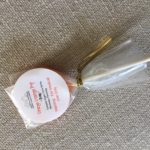
 Today, brands across every sector are facing an increasingly competitive landscape and an increasingly sophisticated consumer. People tend to disregard mass brand communications in favor of more personalized messaging mediums. Packaging has the
Today, brands across every sector are facing an increasingly competitive landscape and an increasingly sophisticated consumer. People tend to disregard mass brand communications in favor of more personalized messaging mediums. Packaging has the  An experienced designer can look at the product and create packaging that is sophisticated, appealing and true to the product inside. There’s really no reason that cartoons, colors and childish fonts need to be used in cannabis products.
An experienced designer can look at the product and create packaging that is sophisticated, appealing and true to the product inside. There’s really no reason that cartoons, colors and childish fonts need to be used in cannabis products. 



 Eric has been working with investors and startups outside of cannabis for a decade at the Michigan SBDC and since leaving the SBDC has been helping bridge the funding gap in the cannabis space. His company, Left Coast Capital works with investors looking for solid businesses, in cannabis and other businesses as well.
Eric has been working with investors and startups outside of cannabis for a decade at the Michigan SBDC and since leaving the SBDC has been helping bridge the funding gap in the cannabis space. His company, Left Coast Capital works with investors looking for solid businesses, in cannabis and other businesses as well.  8) You must be able to talk about how you’re going to handle cash and mitigate the risk involved with it. “Investors want to know that their investment won’t be lost at gunpoint. Know what you’re doing to handle cash and security.”
8) You must be able to talk about how you’re going to handle cash and mitigate the risk involved with it. “Investors want to know that their investment won’t be lost at gunpoint. Know what you’re doing to handle cash and security.”


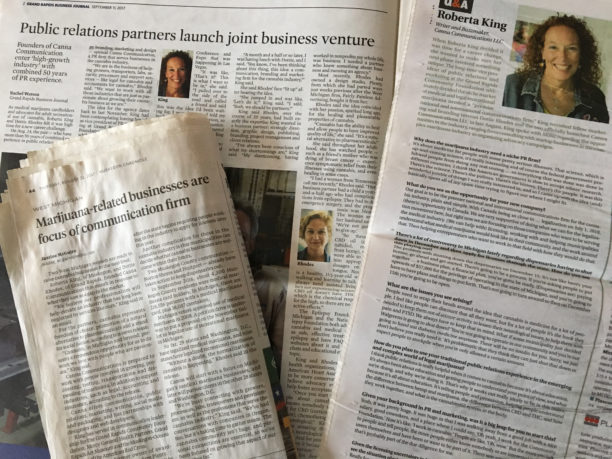
 there.This is where you explore your potential audiences, your competition, the landscape of legislation and how people are reacting to what you are doing. You can read articles on a topic you want to know more about, you can ask questions of people who are potential customers; you can do a Survey Monkey or a poll on Twitter or Facebook.
there.This is where you explore your potential audiences, your competition, the landscape of legislation and how people are reacting to what you are doing. You can read articles on a topic you want to know more about, you can ask questions of people who are potential customers; you can do a Survey Monkey or a poll on Twitter or Facebook.
 Want to learn more about public relations for your cannabis business and how to expand your reach? Let’s talk!
Want to learn more about public relations for your cannabis business and how to expand your reach? Let’s talk!